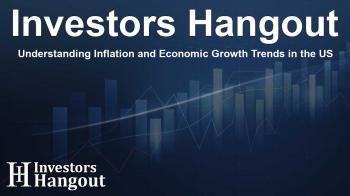Understanding Inflation and Economic Growth Trends in the US

Current Economic Landscape: Inflation and Growth
In recent times, the markets have been recalibrating their expectations regarding the Federal Reserve's interest rate policies following some assertive remarks from Fed officials. Current economic indicators suggest that the economy is showcasing robust momentum. However, inflation remains a persistent concern, particularly as potential tariff implementations begin to influence corporate strategies and decision-making.
Impact of Clear Election Outcomes on Business Activity
The clarity brought about by recent election results has led to increased business activities. Many companies that had postponed investments and hiring due to uncertainties regarding elections and regulations are now beginning to allocate funds for growth. This observation aligns with the latest findings from the ISM purchasing managers’ indices, which reveal encouraging trends in both manufacturing and services sectors.
Last week, the manufacturing index indicated healthy output gains, while the services index has impressively exceeded expectations, rising to a level of 54.1, a noticeable improvement from 52.1. This is significantly higher than the forecasted consensus of 53.5, marking a promising outlook for business activity.
Business Activity and GDP Growth Correlation
Business activity has been reported at a strong level of 58.2, comfortably above the critical threshold of 50 that differentiates economic expansion from contraction. Furthermore, new orders saw a rise to 54.2 from a previous 53.7, pointing to a sustained growth trajectory. This positive momentum is bolstered by a correlation observed in the ISM business activity series and GDP growth, further indicating the economy's resilience.
Challenges: Shrinking Backlogs and Employment Trends
Nevertheless, some challenges persist. A notable disappointment is the significant reduction in the backlog of orders, which raises questions about future production capabilities. Additionally, the employment metrics indicate only modest growth in job creation, alongside increasing inflation pressures. The prices paid index has shot up to 64.4, the highest level since early 2023, further emphasizing the inflationary environment businesses are facing.
Job Market Insights and Future Expectations
The job market appears to present mixed signals with the latest job postings indicating an increase to 8.098 million positions in November, up from 7.839 million in October, surpassing the consensus estimate of 7.74 million. However, the quits rate has declined to 1.9% from a previous 2.1%, highlighting a cautious approach among workers regarding job mobility. This tendency can lead to less pressure on employers to increase wages broadly, aiding in the moderation of inflationary risks in the medium to long term.
Sector-Specific Job Growth and Economic Predictions
Examining the non-farm payroll data, it's evident that a significant portion of job growth, about 78%, has been concentrated in just three sectors: leisure and hospitality, private education, and healthcare services, which are primarily characterized by lower pay and increased part-time work opportunities. Looking ahead to upcoming jobs reports, indicators suggest muted hiring activity; however, favorable weather conditions may have mitigated typical seasonal layoffs in sectors like construction.
Considering the growth potential, moderating inflation concerns, and a jobs market that is slowing but not faltering, it seems that the market is recalibrating its projections for interest rate cuts this year. Currently, only a nominal 35 basis points is factored in, with the first potential rate cut not anticipated until mid-year.
Frequently Asked Questions
What are the main factors affecting the current US economy?
The US economy is influenced by a combination of strong growth indicators, persistent inflationary pressures, and evolving corporate strategies in response to recent elections.
How have recent election outcomes impacted businesses?
The clarity from election results has encouraged businesses to resume investments and hiring that had been previously stalled due to regulatory uncertainty.
What does the ISM index indicate about economic trends?
The ISM index reveals significant growth in both manufacturing and services sectors, signaling robust economic momentum.
What is the current state of the job market in the US?
The job market shows an increase in openings, but a decrease in the quits rate suggests workers are hesitant to change jobs, impacting wage growth.
What might influence future interest rate decisions by the Federal Reserve?
Future interest rate adjustments will likely be influenced by economic growth metrics, inflation levels, and labor market dynamics.
About Investors Hangout
Investors Hangout is a leading online stock forum for financial discussion and learning, offering a wide range of free tools and resources. It draws in traders of all levels, who exchange market knowledge, investigate trading tactics, and keep an eye on industry developments in real time. Featuring financial articles, stock message boards, quotes, charts, company profiles, and live news updates. Through cooperative learning and a wealth of informational resources, it helps users from novices creating their first portfolios to experts honing their techniques. Join Investors Hangout today: https://investorshangout.com/
Disclaimer: The content of this article is solely for general informational purposes only; it does not represent legal, financial, or investment advice. Investors Hangout does not offer financial advice; the author is not a licensed financial advisor. Consult a qualified advisor before making any financial or investment decisions based on this article. The author's interpretation of publicly available data shapes the opinions presented here; as a result, they should not be taken as advice to purchase, sell, or hold any securities mentioned or any other investments. The author does not guarantee the accuracy, completeness, or timeliness of any material, providing it "as is." Information and market conditions may change; past performance is not indicative of future outcomes. If any of the material offered here is inaccurate, please contact us for corrections.
